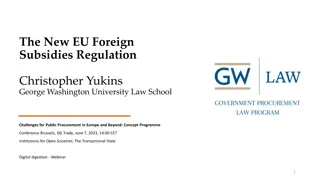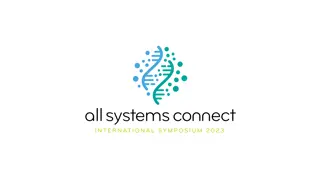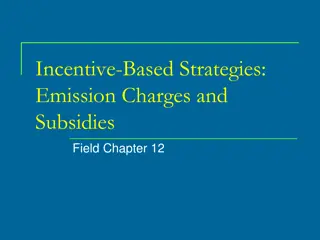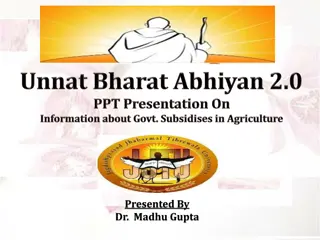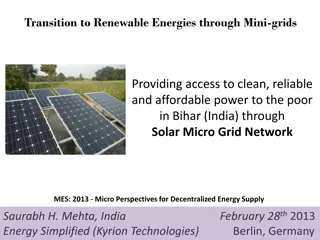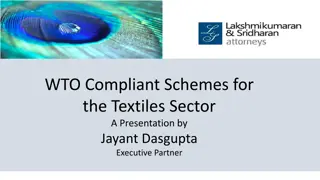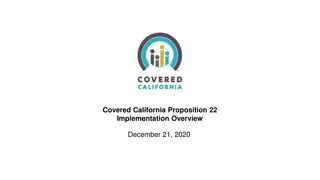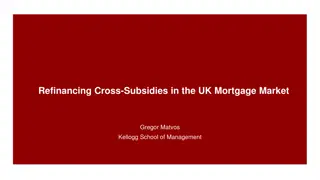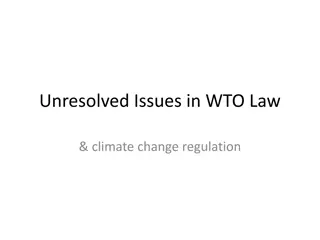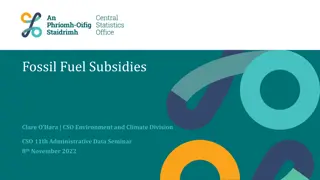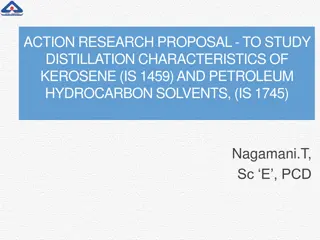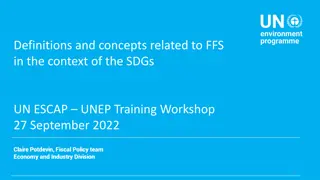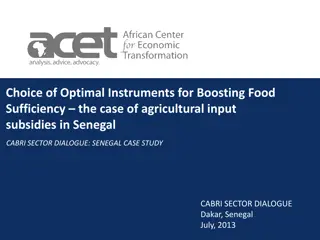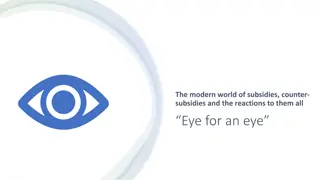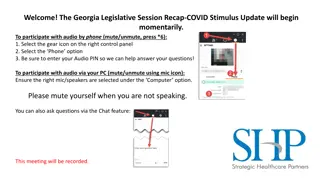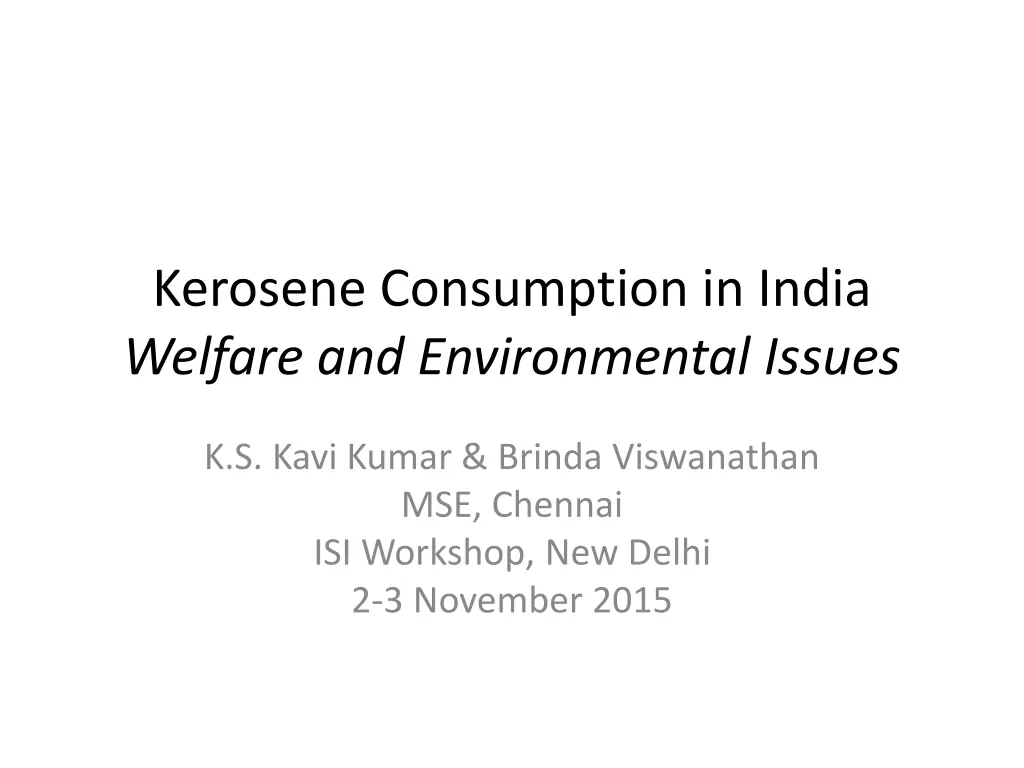
Kerosene Consumption in India: Welfare and Environmental Impacts
This study examines the trends in kerosene usage in India, highlighting the decline in consumption, implications on indoor air pollution, and the role of kerosene subsidies in supporting economically weaker sections. The research underscores the need for increased LPG penetration to reduce health burdens and promote cleaner energy sources.
Download Presentation

Please find below an Image/Link to download the presentation.
The content on the website is provided AS IS for your information and personal use only. It may not be sold, licensed, or shared on other websites without obtaining consent from the author. If you encounter any issues during the download, it is possible that the publisher has removed the file from their server.
You are allowed to download the files provided on this website for personal or commercial use, subject to the condition that they are used lawfully. All files are the property of their respective owners.
The content on the website is provided AS IS for your information and personal use only. It may not be sold, licensed, or shared on other websites without obtaining consent from the author.
E N D
Presentation Transcript
Kerosene Consumption in India Welfare and Environmental Issues K.S. Kavi Kumar & Brinda Viswanathan MSE, Chennai ISI Workshop, New Delhi 2-3 November 2015
Context & Main Argument Based on primary fuel consumption data, NSSO (2015) highlights that incidence of kerosene as primary fuel (in urban areas) has declined by 74% between 1999-2000 and 2011-12 The Economic Survey (2014-15) observes that only a smaller fraction of poorer households (46%) use kerosene for cooking needs Further there is growing increasing leakages and diversion of kerosene and need to contain increasing fiscal burden on account of kerosene subsidy concern about
Context & Main Argument (contd.) While all of this is factual, we argue here based on regional analysis that unless LPG penetration increases dramatically both in rural and urban areas, drop in kerosene supply and consumption leads to increase in indoor air pollution and undermines efforts to reduce health burden The Southern, Western and Northern states which have better penetration of LPG in urban areas do show significant decline in indoor air pollution The urban areas of Eastern states and the rural areas of Southern states also show decline in indoor air pollution due to better functioning PDS and hence greater use of kerosene in supplementing their cooking energy needs away from coke/coal and firewood, respectively In the absence of these options, the rural areas of Eastern, Central and Northern states move towards other dirty fuels (dung and crop residue)
Context & Main Argument (contd.) Apart from the reduction of indoor air pollution, the kerosene subsidy continues to provide implicit income transfer to socially and economically weaker sections and such transfers are progressive Related literature Datta, 2010; Rao, 2012; Anand et al., 2013; Basole and Basu, 2015
Objectives This study focuses on kerosene used by the households and explores the following issues: Primary fuel choice vs energy mix in cooking fuels Market vs PDS kerosene consumption spatial issues Indoor air pollution spatial and temporal trends Role of kerosene in determining indoor air pollution Changes in progressivity of income transfers
Data The study uses unit record data from two NSS rounds 66th (2009-10) and 68th(2011-12) In particular the study uses consumption data reported by the households for cooking and lighting purposes Analysis is mostly at geographic zones and expenditure deciles in rural and urban areas North: J&K, Haryana, Punjab, HP, and Delhi Central: MP, Chattisgarh, UP, and Uttaranchal West: Rajsthan, Gujarat, Maharashtra, and Goa East: Assam, Bihar, Orissa, WB, and NE South: AP, Karnataka, Kerala and TN
The present work is extension of our earlier works in this area including Analysis of trends in fuel use patterns across India (Viswanathan and Kumar, 2005); Analysis of indoor air pollution patterns (Kumar and Viswanthan, 2007); Analysis of patterns and projections of household level pollution (local and global components) in India (Kumar and Viswanathan, 2013); Analysis of implicit income transfers and functioning and non- functioning states with respect to PDS kerosene (Kumar and Viswanathan, 2015)
Primary Cooking Fuel: Rural 2004-05 2009-10 2011-12 Use of others as pry fuel increased Central and East Kerosene as pry fuel declined in all zones
Primary Cooking Fuel: Urban 2004-05 2009-10 2011-12 Greater LPG penetration more so in North and South led to decline in firewood as well as kerosene
Cooking Energy Estimation Cooking energy at household level is estimated based on energy content and thermal efficiency reported in Smith et al. (2000), Venkataraman et al. (2010), and Mestl and Eskeland (2009) Total consumption of kerosene is allocated between cooking and lighting needs based on the household s choice of cooking and lighting primary fuels Dung and other cooking fuels (e.g., crop residue) should be accounted though the quantity data is missing in the NSS database Households with no cooking arrangement are excluded
Accounting for Other Cooking Fuels Estimate the mean energy at decile level in each zone for a particular sector from the fuels with quantity data For household which report positive expenditure on dung and other energy, the energy from these fuels is attributed as the residual of mean cooking energy and their own total energy from the fuels with quantity data This correction may not still accurately capture the energy from other fuels underestimate the indoor pollution that we discuss later and hence would
Expenditure share of dung and other fuels is showing increasing trend across zones and for most deciles over time
2009-10, Rural North 2011-12, Rural North Share of fuels in Household Energy-mix 2009-10, Rural Central 2011-12, Rural Central 2009-10, Rural East 2011-12, Rural East
2009-10, Rural North 2011-12, Rural North Other fuels have significant share in the household s cooking energy mix In North, Central and East, share of Kerosene both PDS and Market is low (compared to West and South) and is declining over time 2009-10, Rural Central 2011-12, Rural Central 2009-10, Rural East 2011-12, Rural East
2009-10, Rural South 2011-12, Rural South Urban to rural diversion of PDS kerosene for cooking facilitating drop in indoor pollution Similar pattern in West with regard to kerosene consumption in rural areas 2009-10, Urban South 2011-12, Urban South
Indoor Air Pollution Estimation Using emission coefficients reported in the literature (Smith et al., 2000; Venkataraman et al., 2010), along with the fuel consumption quantities and the attributed cooking energy from other fuels, household level particulate matter emissions are estimated The emission estimates are approximate as no information is available on stove efficiency, kitchen characteristics and missing quantitative data on other fuels Spatial and temporal patterns of the estimated PM emissions are analysed Role of household s consumption of kerosene in explaining the variation in PM emissions is explored using econometric specification
Particulate Matter Emissions 2009-10 2011-12 2009-10 2011-12
Particulate Matter Emissions North: 2009-10 & 2011-12 Higher emissions in 2011- 12 in the expenditure decile in rural areas Similar patterns in Central and Western Zones lower Lower emissions in the lower expenditure deciles of rural areas than those in urban areas Improper accounting of energy from other fuels? Energy poverty? East: 2009-10 & 2011-12
Rural Indoor Air Pollution: Role of Kerosene Dependent variable: log per capita particulate emissions Rural 2009-10 lnmpce sqlnmpce prmfwd prmlpg shkeropds shkeromkt R-squared= Number of obs = North Central West East South All India Coeff 1.422 -0.082 1.292 -1.490 -0.228 -1.223 p-value 0.017 0.045 0.000 0.000 0.012 0.000 0.5719 7191 Coeff 0.532 -0.025 0.914 -1.616 -0.610 -2.439 p-value 0.380 0.591 0.000 0.000 0.004 0.000 0.4997 11799 Coeff 2.350 -0.152 1.637 -0.809 -0.455 -1.401 p-value 0.000 0.000 0.000 0.003 0.010 0.000 0.5510 8602 Coeff 1.148 -0.061 1.361 -1.707 -0.543 -2.947 p-value 0.093 0.234 0.000 0.000 0.073 0.000 0.6108 18848 Coeff 0.658 -0.040 1.074 -1.195 -0.611 -2.040 p-value 0.041 0.074 0.001 0.000 0.004 0.000 0.5376 12180 Coeff 1.199 -0.071 1.141 -1.413 -0.497 -2.203 p-value 0.000 0.000 0.000 0.000 0.000 0.000 0.5477 58620 Rural 2011-12 lnmpce sqlnmpce prmfwd prmlpg shkeropds shkeromkt R-squared= Number of obs = North Central West East South All India Coeff 0.602 -0.042 1.375 -1.898 -1.479 -2.358 p-value 0.329 0.307 0.000 0.000 0.000 0.000 0.6719 7804 Coeff 1.691 -0.103 0.891 -1.764 -0.836 -1.857 p-value 0.000 0.000 0.000 0.000 0.000 0.000 0.532 11797 Coeff 1.683 -0.109 1.704 -0.560 -0.465 -1.702 p-value 0.000 0.000 0.000 0.000 0.004 0.000 0.5447 8583 Coeff 2.103 -0.132 1.308 -1.677 -1.178 -3.385 p-value 0.001 0.002 0.000 0.000 0.000 0.000 0.6206 18906 Coeff 1.376 -0.084 0.383 -1.683 -1.622 -2.892 p-value 0.004 0.009 0.043 0.000 0.000 0.000 0.5001 12237 Coeff 1.993 -0.126 1.109 -1.407 -0.939 -2.422 p-value 0.000 0.000 0.000 0.000 0.000 0.000 0.5505 59327 J&K Prmfwd, prmlpg firewood and LPG as pry fuels (dummy) Shkeropds, shkeromkt share of kerosene (from PDS and Mkt) in the household energy mix Includes relevant control variables like demographic and social characteristics
Rural Indoor Air Pollution: Role of Kerosene Indoor pollution broadly declines over time in rural areas driven largely by LPG penetration This obscures the role played by the reduction in supply and consumption of kerosene on indoor pollution Regression results clearly highlight the role of kerosene (in the fuel mix) in decreasing the indoor pollution, with an increasing magnitude over time Kerosene sourced from market has played relatively more significant role than the PDS kerosene in reducing indoor pollution
Is Kerosene Reaching the Needy? The implicit income transfers to the household due to purchase of PDS kerosene are estimated as Income Transfer = QPDS*(PKMarket PKPDS) The income transfers are expressed as percentage of total expenditure and analysed across zones, decile groups and social groups These income transfers approximations as actual transfers will depend on substitution possibilities between kerosene and other fuels captured through the relevant elasticities and accessibility are first order
Over the period 2004-2012, PDS kerosene consumption has increased and then decreased in rural, whereas it uniformly decreased in urban areas Share of income transfer in total household expenditure is uniformly higher in rural (poorer regions) than in urban Eastern region which has relatively more poor population, shows higher share of income transfer Income transfers in Southern and Western zones become comparable with those of Central (where poor population is higher again) perhaps due to better targeting and functioning of PDS
Bottom 20% of population benefit more than middle 30-70% Urban benefit more due to higher kerosene consumption than rural population Rural Central and East report uniform benefits for both groups due to inadequate penetration of LPG
SC/ST population benefit more than others throughout except in Central and Eastern zones where inadequate penetration of LPG is perhaps leading to the diversion
Progressivity/Regressivity Kerosene Subsidy Based on 2004-05 data, Rao (2012) argued that the kerosene subsidy benefits are regressive in rural Maharashtra, and that they are progressive in the urban areas Evidence from subsequent years 2009-10 & 2011-12 suggests progressivity in both rural and urban Maharashtra
Diversion of Kerosene Status and Trends Kerosene is allocated on the basis of two household characteristics number of LPG cylinders and household size Since lower income households tend to have fewer LPG cylinders and larger family size, the kerosene subsidy does have the potential to serve as a redistributive instrument Kerosene allotted to a state through PDS finds its way to two other markets black market where the households can purchase kerosene for household purposes and to other markets for adulteration purposes The significant diversion has often been cited as reason for doing away with kerosene subsidy Diversion in a state is estimated as percentage of aggregate household level consumption of kerosene in a given year to the offtake of that state in the same year
80 Eastern zone shows sharpest followed Southern zone Northern Western continue to have high diversion rates 70 increase, by North 60 the Central 50 West and zones East 40 South 30 20 2004-05 2009-10 2011-12 % Diversion with respect to All India Average Diversion 40.00 Less diversion than all India 30.00 20.00 10.00 0.00 More diversion than all India -10.00 -20.00 -30.00 -40.00 -50.00 Orissa Goa Delhi Punjab Karnataka Kerala West Bengal Chhattisgarh Tamil Nadu Bihar Jharkhand Gujrat Uttar Pradesh Uttaranchal Haryana Jammu & Kashmir Assam Maharastra Himachal Pradesh Rajasthan Madhya Pradesh Andhra Pardesh 2004-05 2009-10 2011-12
Concluding Remarks Significant diversion of kerosene to othermarkets continues Provides ground for phasing out kerosene subsidy However, targeting has improved over years and the subsidy benefits are by and large progressive across zones and sectors Allocation and offtake of kerosene have declined in recent years; also reflected in considerable reduction in household level consumption across zones and sectors in 2011-12 Declining consumption of kerosene can have adverse welfare and environmental effects Poorer states, rural areas, lower income groups, and disadvantaged social groups are likely to lose out more Reduction in kerosene supply is pushing households to supplement their cooking energy needs through use of cheaper and dirty fuels such as dung and crop residue
Concluding Remarks Need for providing effective alternatives to minimize the adverse implications In case of cooking in addition to increasing penetration of LPG, efforts should be made to increase use of improved cook stoves, which could provide win-win option of reducing both local and global pollution In case of lighting in addition to increasing electrification, efforts should also be made to explore the solar options

